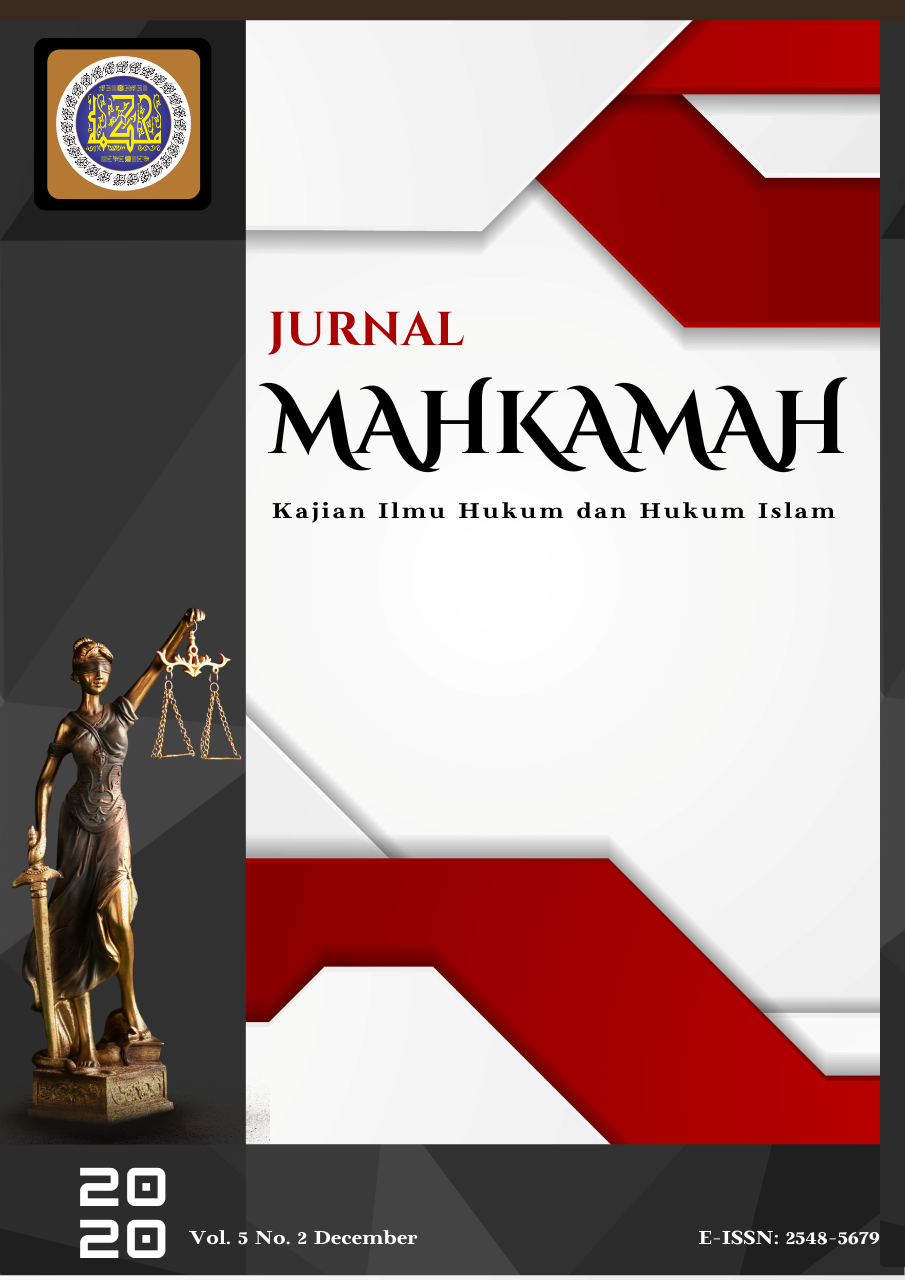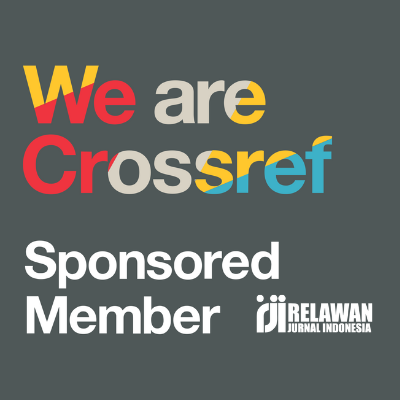Legalization of Pre-Marriage Agreement Pandhābā from Islamic Law Perspective
(A Case Study in Bakeong Village, Sumenep)
DOI:
https://doi.org/10.25217/jm.v5i2.1017Keywords:
Islamic law, Pandhābā, TraditionAbstract
The pre-marriage pandhābā legalization in Bakeong Village, Guluk-Guluk, Sumenep is a procession of efforts to free a pandhābā child from bad luck and all forms of distress in his life which are carried out before the marriage ceremony procession. There are two objectives in this research; first, to find out the procession of implementing the tradition, and the second how was the view of Islamic law on the tradition. The research used a normative-qualitative approach with a type of case studies. Collecting data through unstructured interviews, non-participant observation and documentation. Data were analyzed using deductions, presentations and conclusions deductively. Data sources were from people who understood and were directly involved in the implementation, and from other records relating to the object of research. The research results were, firstly; In the pandhābā legalization procession there were several stages, such as attributes (sesajen) to be used, rasolan and khatmil Qur`ān, and bathing the pandhābā children with the water of seven wells and campoan mixed with flowers. Second; this research of Islamic law toward the tradition is not found any deviation. Even this tradition can be said to be sunnah to do, because it was full of Islamic teachings such as alms and pray together.
References
Abdusshomad, Muhyidin. FiqhTradisional. Malang: Pustaka Bayan, 2004.
Akhyat, Arif, D.S. Nugrahani, Marsono, Sri RatnaSakriMulya, and Wisma Nugraha Chr. EnsiklopediPamekasan; Alam, Masyarakat, dan Budaya. Edited by ChairilBasar, Ida Rochani Adi, InajatiAdrisjianti, KadarismanSastrodiwirjo, M. Yusuf Suhartono, Sonny Budhiarto, and Sugihastuti. Pertama. Yogyakarta: PemerintahKabupatenPamekasan, 2010.
Ali, Muhammad. “Muslim Diversity: Islam and Local Tradition in Java and Sulawesi, Indonesia.” Indonesian Journal of Islam and Muslim Societies 1 (June 1, 2011): 1. https://doi.org/10.18326/ijims.v1i1.1-35.
Arifin, Samsul. “Sastra PesantrenUntukMenguatkan Kembali Kebersamaan (Kajian Teks Dan KonteksDoaPangrokat),” n.d. http://repositori.kemdikbud.go.id/10065/1/dokumen_makalah_1540519422.pdf.
‘Asqalānī, ‘Alī bin Aḥmad bin Ḥajar al-. Muwāfaqah Al-Khubra al-Khabar FīTakhrījAḥādīṡ al-Mukhtaṣar. Edited by Ḥamdi ‘Abd al-Majīd al-Salafī and Subḥi al-Sayyid Jāsim al-Sāmirāī. 2nd ed. Vol. 2. 5 vols. Riyāḍ: al-Rusyd, 1993.
Bukhārī, Abū ‘AbdullāhMuḥammad bin Ismā’īl al-. al-Jāmi’ al-Ṣaḥīḥ. Edited by Muhib al-Dīn al-Khaṭīb. I. Vol. 1. 4 vols. Kairo: al-Salafiyyah, 1400.
Chair, Badrul. “DimensiKosmologis Ritual RokatPandhaba Pada Masyarakat Madura.” Jurnal SMART (Studi Masyarakat, Religi, Dan Tradisi) 6 (June 29, 2020): 127–41. https://doi.org/10.18784/smart.v6i1.952.
Darmawan, MardianDwi. “TradisiRokatPandhâbâDalam Masyarakat Madura Di DesaKalisatKecamatanKalisatKabupatenJember.” Skripsi, Universitas Jember, 2014.
Departemen Agama RI. Syaamil al-Qur`an The Miracle 15 in 1. Bandung: PT. SygmaExamediaArkanleema, 2009.
Efendi, Jonaedi, and Jhonny Ibrahim. MetodePenelitian Hukum. Depok: Prenadamedia Group, 2016.
Ḥanbal, Aḥmad bin Muḥammad bin. Al-Musnad. Edited by AḥmadMuḥammadSyākir. 1st ed. Vol. 3. 15 vols. Kairo: Dār al-Ḥadīṡ, 1995.
Hasanah, Faizzatul. “AnalisisKebudayaanLokal Madura RokatPandhaba di DesaDurbukPademawuPamekasan Madura.” Academia.edu, n.d. https://www.academia.edu/36808773/Analisis_Kebudayaan_Lokal_Madura_Rokat_Pandhaba_di_Desa_Durbuk_Pademawu_Pamekasan_Madura.
Hermansyah, Hermansyah. “Islam and Local Culture in Indonesia.” Al-Albab - Borneo Journal of Religious Studies 3, no. 1 (June 1, 2014): 55–66. https://doi.org/10.24260/alalbab.v3i1.94.
Hermawan, Iwan. UshulFiqhMetode Kajian Hukum Islam. Kuningan: Hidayatul Qur`an, 2019.
Hidayaturrahman, Mohammad. “Integration of Islam and Local Culturer: Tandhe’ in Madura.” Miqot XLII, no. 1 (2018): 189–206.
Indriani, Dian Eka, M. Sahid, BachtiarSyaifulBachri, and Umi AnugrahIzzati. “Traditions: Radical or Peace-Building.” Atlantis Press, January 2019. Proceedings of the International Conference on Religion and Public Civilization (ICRPC 2018). https://doi.org/10.2991/icrpc-18.2019.3.
Jauziyyah, Syams al-DīnAbū ‘Abd AllāhMuḥammad bin Qayyim al-. Al-Wābil al-Ṣayyab Min al-Kalam al-Ṭayyib. Edited by ‘Abd al-Qādir al-Arnāuṭ and Ibrāhīm al-Arnāuṭ. Damaskus: Dār al-Bayān, 1973.
Khalik, Fathol. “RokatBhuju’ Vis-Ā-Vis Kompolan (MetamorfosisElit Madura PascaKeruntuhan Orde Baru).” Karsa XII, no. 2 (Oktober 2007): 132–48. http://dx.doi.org/10.19105/karsa.v12i2.137.
Khallāf, ‘Abd Wahhab. ‘IlmUṣūl al-Fiqh. 7th ed. Kairo: al-Da’wah al-IslāmiyyahSyabāb al-Azhār, 1965.
Mangini, Michele. “Rationality and Ethics between Western and Islamic Tradition.” Religions 9, no. 302 (2018): 23. http://dx.doi.org/10.339/rel9100302.
Marwati, Anton. “UngkapanTradisionalDalamUpacaraAdatPerkawinan Masyarakat Bajo Di PulauBaluKabupatenMuna Barat.” JurnalHumankia 3, no. 15 (Desember 2015). http://ojs.uho.ac.id/index.php/HUMANIKA/article/view/123456.
Multazam. “Tradisi Ritual RokatPandhâbâ Di DesaPademawu Barat KecamatanPademawuKabupatenPamekasan.” Skripsi, STAIN Pamekasan, 2013.
Muyassarah. “Nilai BudayaWalimahPerkawinan (Walīmatul ‘Urusy) dalamPemberdayaanEkonomi Masyarakat (StudiKasus di KelurahanGondorioNgaliyan Semarang).” Inferensi; JurnalPenelitianSosialKeagamaan 10, no. 2 (Desember 2016): 539–58. http://dx.doi.org/10.18326/infsl3.v10i2.539-558.
Prihantini, Peni. “Ritual RokatPandhâbâDalamPertunjukan Topeng Dhalang ‘RukunPewaras’ Slopeng Kajian Bentuk Dan Fungsi.” Terob VIII, no. 1 (Oktober 2017): 54–73.
Rahayu, EkoWahyuni, Wisma Nugraha Ch. R, and A.M. HermienKusmayanti. “RokatPandhâbâSebagaiPertunjukanBudaya Masyarakat Madura Di KabupatenSumenep.” Gētēr; JurnalSeni Drama, Tari, dan Musik 1, no. 1 (Desember 2018). https://journal.unesa.ac.id/index.php/geter/article/view/3921/2209.
Saebani, Beni Ahmad. FiqihMunakahat 1. Bandung: Pustaka Setia, 2001.
Saffan, Edi. “UrgensiDoa, Ikhtiar Dan Kesadaran Beragama Dalam Kehidupan Manusia.” Fitra 2, no. 1 (June 2016): 20–27.
Setiawan, B., M. Abdurrazaq, Abidin, Abidin Zainal, and Achyadi R. Kurnia. Ensiklopedi Nasional Indonesia. 3rd ed. Vol. 14. 18 vols. Jakarta: PT. Delta Pamungkas, 1997.
———. Ensiklopedi Nasional Indonesia. 3rd ed. Vol. 12. 18 vols. Jakarta: PT. Delta Pamungkas, 1997.
———. Ensiklopedi Nasional Indonesia. 3rd ed. Vol. 6. 18 vols. Jakarta: PT. Delta Pamungkas, 1997.
———. Ensiklopedi Nasional Indonesia. 3rd ed. Vol. 10. 18 vols. Jakarta: PT. Delta Pamungkas, 1997.
Sunyoto, Agus. Atlas Walisongo; Buku Pertama yang Mengungkap Wali Songo Sebagai Fakta Sejarah. 1st ed. Depok: Pustaka IIMaN, 2012.
Suyūṭī, Jalāl al-Dīn ‘Abd al-Rahmān al-. al-Asybahwa al-Naẓāirfī Qawāid wa Furū’ Fiqh al-Syāfiiyyah. 2nd ed. Vol. 1. 2 vols. Riyāḍ: NizārMuṣṭafā al-Bāz, 1997.
Syarifuddin, Amin. Garis-Garis BesarFiqh. Jakarta: Prenadamedia Group, 2005.
Ṭabrānī, Abū al-QāsimSulaimān bin Aḥmad al-. Al-Mu’jam al-Ausaṭ. Edited by Ṭāriq bin AuḍAllāh bin Muḥammad and ‘Abd al-Muḥsin bin Ibrāhīm al-Ḥusainī. Vol. 5. 20 vols. Kairo: Dār al-Ḥaramain, 1995.
———. Al-Mu’jam al-Ausaṭ. Edited by Ṭāriq bin AuḍAllāh bin Muḥammad and ‘Abd al-Muḥsin bin Ibrāhīm al-Ḥusainī. Vol. 6. 20 vols. Kairo: Dār al-Ḥaramain, 1995.
———. Al-Mu’jam al-Ausaṭ. Edited by Ṭāriq bin AuḍAllāh bin Muḥammad and ‘Abd al-Muḥsin bin Ibrāhīm al-Ḥusainī. Vol. 8. 20 vols. Kairo: Dār al-Ḥaramain, 1995.
Taimiyyah, Abū al-‘AbbāsTaqiyy al-Dīn Aḥmad bin ‘Abd al-Ḥalīm Ibn. Minhāj Al-Sunnah al-Nabawiyyah. Edited by Muḥammad RasyādSālim. 1st ed. Vol. 2. 5 vols., 1986.
Tim Pakem Maddhu. Kembhâng Bhâbur 3. Jakarta Timur: Yudhistira, 2012.
“Tradisi.” In KamusBesar Bahasa Indonesia (Daring/Online), Mei 2020. https://kbbi.web.id/tradisi.
WR, Syaf Anton. “UpacaraAdatRokatDisa “Ju’ Kae”.” Lontar Madura (blog), Mei 2011. http://www.lontarmadura.com/upacara-adat-rokat-disa-ju-kae-2/.
Zahrah, MuḥammadAbū. Uṣūl al-Fiqh. Kairo: Dār al-Fikr al-‘Arabī, 1965.
Zainuddin. “Tradisi Rokat Pandhaba di Desa Beluk Raja Kecamatan Ambunten Kabupaten Sumenep Provinsi Jawa Timur.” Skripsi, UIN Sunan Kalijaga, 2016. http://digilib.uin-suka.ac.id/21138/.
Zenrif, M. Realitas Keluarga Muslim Antara Mitos Dan Doktrin Agama. Malang: UIN Malang Press, 2008.
Zuḥailī, Wahbah al-. Uṣūl al-Fiqh al-Islāmī. 1st ed. Vol. 1. 2 vols. Damaskus: Dār al-Fikr, 1986.
Downloads
Published
How to Cite
Issue
Section
License
This work is licensed under a Creative Commons Attribution-ShareAlike 4.0 International License.
Authors retain copyright and grant the Jurnal Mahkamah : Kajian Ilmu Hukum Dan Hukum Islam right of first publication with the work simultaneously licensed under a Creative Commons Attribution License (CC BY-SA 4.0) that allows others to share (copy and redistribute the material in any medium or format) and adapt (remix, transform, and build upon the material) the work for any purpose, even commercially with an acknowledgment of the work's authorship and initial publication in Jurnal Mahkamah : Kajian Ilmu Hukum Dan Hukum Islam.
Authors are able to enter into separate, additional contractual arrangements for the non-exclusive distribution of the journal's published version of the work (e.g., post it to an institutional repository or publish it in a book), with an acknowledgment of its initial publication in Jurnal Mahkamah : Kajian Ilmu Hukum Dan Hukum Islam.
Authors are permitted and encouraged to post their work online (e.g., in institutional repositories or on their website) prior to and during the submission process, as it can lead to productive exchanges, as well as earlier and greater citation of published work (See The Effect of Open Access).








